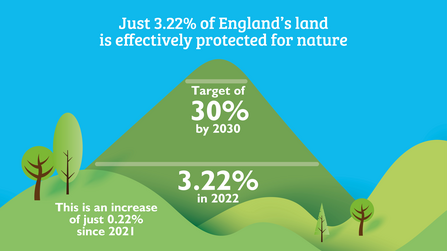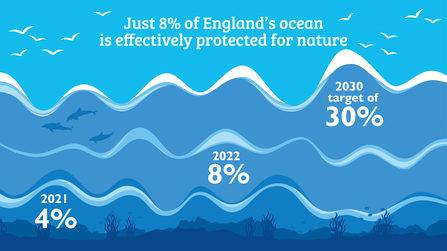- Just 3.22% of England’s land and 8% of the sea was effectively protected by 2022. This is an increase of just 0.22% of the land and 4% of the sea compared with 2021.
-
Deregulatory proposals to liberalise planning laws would take England even further away from meeting nature targets.
-
The report comes just weeks ahead of global nature talks where the UK is expected to sign an international treaty to implement 30x30.
In 2020, the Government committed to protect at least 30% of land and sea for nature by 2030 (its 30x30 target). Two years on, nature campaigners are warning that little progress has been made.
In its first annual 30x30 progress report, Wildlife and Countryside Link is calling on the Prime Minister to send a clear international message that the UK will be a global leader in implementing 30x30. The 30x30 target is expected to be a key commitment in global nature talks at COP15 in Montreal in December.
The report argues that this means “designation, not deregulation” – protecting more land and sea for nature, rather than weakening planning rules. The report singles out the Retained EU Law (Revocation and Reform) Bill for criticism. The bill will reform or repeal hundreds of EU-derived environmental laws by the end of 2023. In particular, plans for “fundamental reform” of the Habitats Regulations could weaken the UK’s most legally-robust laws that defend natural habitats.
Campaigners are also calling on the Prime Minister to confirm her intention to attend COP15 nature talks in person to push for global action to protect and restore nature.
Key figures detailed in the report:
-
Only 3.22% of England’s land is effectively protected for nature.
-
The Government has designated 2831 hectares in three new Sites of Special Scientific Interest (SSSI), contributing 0.22% to the amount of protected land. [1]
-
A maximum of 8% of England’s seas could be said to be effectively protected for nature.
-
The progression of management measures in some Marine Protected Areas has increased the amount of ocean by 4% at most. [2]
The report will be launched at an event in Parliament this morning (19.10.22) with speakers including:
-
Daniel Zeichner MP and Shadow Minister (Environment, Food and Rural Affairs)
-
The Baroness Bakewell of Hardington Mandeville
-
Beccy Speight, CEO, RSPB
-
Craig Bennett, chief executive, The Wildlife Trusts
-
Richard Benwell, CEO, Wildlife and Countryside Link


